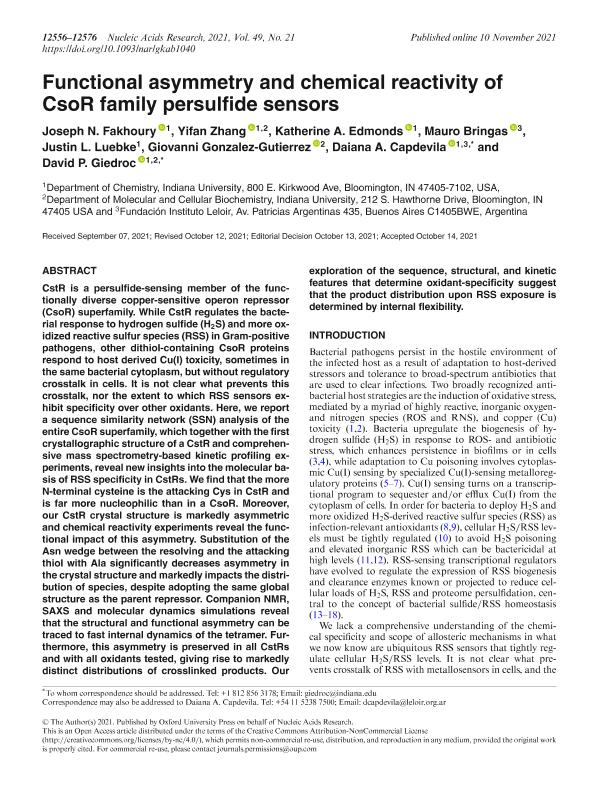Mostrar el registro sencillo del ítem
dc.contributor.author
Fakhoury, Joseph N
dc.contributor.author
Zhang, Yifan
dc.contributor.author
Edmonds, Katherine A
dc.contributor.author
Bringas, Mauro

dc.contributor.author
Luebke, Justin L
dc.contributor.author
Gonzalez Gutierrez, Giovanni
dc.contributor.author
Capdevila, Daiana Andrea

dc.contributor.author
Giedroc, David Peter

dc.date.available
2022-09-01T13:44:43Z
dc.date.issued
2021-12
dc.identifier.citation
Fakhoury, Joseph N; Zhang, Yifan; Edmonds, Katherine A; Bringas, Mauro; Luebke, Justin L; et al.; Functional asymmetry and chemical reactivity of CsoR family persulfide sensors; Oxford University Press; Nucleic Acids Research; 49; 21; 12-2021; 12556-12576
dc.identifier.issn
0305-1048
dc.identifier.uri
http://hdl.handle.net/11336/167149
dc.description.abstract
CstR is a persulfide-sensing member of the functionally diverse copper-sensitive operon repressor (CsoR) superfamily. While CstR regulates the bacterial response to hydrogen sulfide (H2S) and more oxidized reactive sulfur species (RSS) in Gram-positive pathogens, other dithiol-containing CsoR proteins respond to host derived Cu(I) toxicity, sometimes in the same bacterial cytoplasm, but without regulatory crosstalk in cells. It is not clear what prevents this crosstalk, nor the extent to which RSS sensors exhibit specificity over other oxidants. Here, we report a sequence similarity network (SSN) analysis of the entire CsoR superfamily, which together with the first crystallographic structure of a CstR and comprehensive mass spectrometry-based kinetic profiling experiments, reveal new insights into the molecular basis of RSS specificity in CstRs. We find that the more N-terminal cysteine is the attacking Cys in CstR and is far more nucleophilic than in a CsoR. Moreover, our CstR crystal structure is markedly asymmetric and chemical reactivity experiments reveal the functional impact of this asymmetry. Substitution of the Asn wedge between the resolving and the attacking thiol with Ala significantly decreases asymmetry in the crystal structure and markedly impacts the distribution of species, despite adopting the same global structure as the parent repressor. Companion NMR, SAXS and molecular dynamics simulations reveal that the structural and functional asymmetry can be traced to fast internal dynamics of the tetramer. Furthermore, this asymmetry is preserved in all CstRs and with all oxidants tested, giving rise to markedly distinct distributions of crosslinked products. Our exploration of the sequence, structural, and kinetic features that determine oxidant-specificity suggest that the product distribution upon RSS exposure is determined by internal flexibility.
dc.format
application/pdf
dc.language.iso
eng
dc.publisher
Oxford University Press

dc.rights
info:eu-repo/semantics/openAccess
dc.rights.uri
https://creativecommons.org/licenses/by-nc/2.5/ar/
dc.subject
TRANSCRIPTIONAL REGULATORS
dc.subject
RSS
dc.subject
STREPTOCOCCUS PNEUMONIAE
dc.subject
FUNCTIONAL ASSYMMMETRY
dc.subject.classification
Biofísica

dc.subject.classification
Ciencias Biológicas

dc.subject.classification
CIENCIAS NATURALES Y EXACTAS

dc.title
Functional asymmetry and chemical reactivity of CsoR family persulfide sensors
dc.type
info:eu-repo/semantics/article
dc.type
info:ar-repo/semantics/artículo
dc.type
info:eu-repo/semantics/publishedVersion
dc.date.updated
2022-08-19T18:14:10Z
dc.identifier.eissn
1362-4962
dc.journal.volume
49
dc.journal.number
21
dc.journal.pagination
12556-12576
dc.journal.pais
Reino Unido

dc.journal.ciudad
Oxford
dc.description.fil
Fil: Fakhoury, Joseph N. Indiana University; Estados Unidos
dc.description.fil
Fil: Zhang, Yifan. Indiana University; Estados Unidos
dc.description.fil
Fil: Edmonds, Katherine A. Indiana University; Estados Unidos
dc.description.fil
Fil: Bringas, Mauro. Consejo Nacional de Investigaciones Científicas y Técnicas. Oficina de Coordinación Administrativa Parque Centenario. Instituto de Investigaciones Bioquímicas de Buenos Aires. Fundación Instituto Leloir. Instituto de Investigaciones Bioquímicas de Buenos Aires; Argentina
dc.description.fil
Fil: Luebke, Justin L. Indiana University; Estados Unidos
dc.description.fil
Fil: Gonzalez Gutierrez, Giovanni. Indiana University; Estados Unidos
dc.description.fil
Fil: Capdevila, Daiana Andrea. Indiana University; Estados Unidos. Consejo Nacional de Investigaciones Científicas y Técnicas. Oficina de Coordinación Administrativa Parque Centenario. Instituto de Investigaciones Bioquímicas de Buenos Aires. Fundación Instituto Leloir. Instituto de Investigaciones Bioquímicas de Buenos Aires; Argentina
dc.description.fil
Fil: Giedroc, David Peter. Indiana University; Estados Unidos
dc.journal.title
Nucleic Acids Research

dc.relation.alternativeid
info:eu-repo/semantics/altIdentifier/doi/http://dx.doi.org/10.1093/nar/gkab1040
dc.relation.alternativeid
info:eu-repo/semantics/altIdentifier/url/https://academic.oup.com/nar/article/49/21/12556/6424783
Archivos asociados
